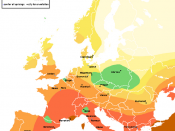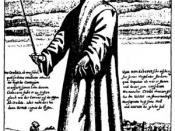The Black Death.
During the 1300's the Asian and Muslim worlds were both infested with the bubonic plague- a deadly disease that wiped out almost one-third of Europe's population.
In art, the time period of the bubonic plague appropriately depicts death as a skeleton on horseback who uses a scythe to cut people down. It is an image we have come to know and recognize today as the Grim Reaper.
The plague began in Asia, traveling from Asia and infecting most of the Muslim world, it spread all the way to Europe. This became the disease the people knew as The Black Death. The bubonic plague was the cause of such terror that it ripped apart the very fabric of society. An Italian writer of the time wrote on how the plague split up society:
"The scourge had implanted so great a terror in the hearts of men and women that brother abandoned brothers, uncles their nephews, sisters their brothers, and in many cases wives deserted their husbands.
But even worse... Fathers and mothers refused to nurse and assist their own children." (Rond, McNally, pg 420)
Death tolls went as high as 20-25 million in Western Europe, 4 million in Southwest Asia, and 35 million in China. A Welsh poet in 1349 described the plague as well:
"We see death coming into our midst like black smoke..."
Looking for a scapegoat, people blamed the Jews for causing the bubonic plague, saying that the Jews were poisoning the wells. All over Europe Jews were massacred.
The economy suffered enormously under the effects of the Black Death. Trade decline, prices rose; the decrease in population meant there were fewer workers; serfs and peasant left in search of higher wages; peasants rebelled in many European countries.
Prayers and penances of...


